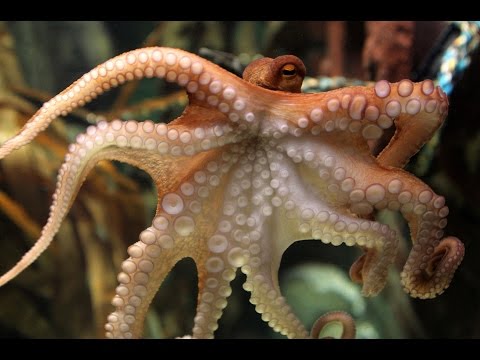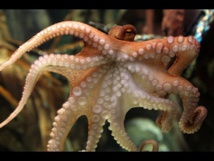By closely studying how these soft-bodied swimmers do it, engineers and biologists joined in a nearly three-year-long US Navy-funded research collaboration to create a material that acts in a similar way.
The team's initial result, described in this week's edition of the Proceedings of the National Academy of Sciences, is far from ready for commercial use.
But architects, interior designers, fashion houses and the military all have their eyes on its eventual capability to provide a first-of-its-kind man-made camouflaging material, experts say.
"If you illuminate it with white light and different patterns, it will automatically respond to that and produce a pattern that matches," said lead author John Rogers, a professor in the department of materials science and engineering at the University of Illinois.
"Having said that, we are a long way from color-morphing wallpaper, but it is a step that could lead in that direction over time," he told AFP.
The flexible material's layers include temperature-sensitive dye and photosensors that respond in one to two seconds to changing patterns.
The dye appears black at low temperatures and clear at temperatures above 47 degrees Celsius (117 degrees Fahrenheit).
"These devices are capable of producing black-and-white patterns that spontaneously match those of the surroundings, without user input or external measurement," said the study.
The international research team included chemistry and mechanics experts at leading Chinese institutions as well as Roger Hanlon, a top world expert on the physiology of cephalopod skin.
- Patterns help avoid predators -
"Adaptive camouflage is extremely important to this animal group," explained Hanlon, senior scientist at the Marine Biological Laboratory in Woods Hole, Massachusetts.
Since cephalopods are soft-bodied and are in the middle of the food chain, they are under constant threat from diving birds, barracuda and other fish that want to eat them.
Therefore, they have evolved the ability to quickly survey their surroundings and turn on the right camouflage pattern, choosing from three to five basic templates in their repertoire.
"Within a second, in general, they are doing this magical process of looking at this complex visual world immediately surrounding them," said Hanlon.
"That is stunning. There is no other animal group that can do it."
These skills help them escape predators and attack prey.
Hanlon said his lab has published research showing that cephalopods seemed to have light sensors distributed throughout the skin which they presumably use to create the appropriate disguises.
"We only proved that the molecules were there, we couldn't prove that they were doing something with light. We are still looking at that," Hanlon said.
"We didn't think that should hold John back. He took the idea and embedded them in his materials the way we think animals do."
In that sense, the mechanical engineers on the team were able to make a material that was inspired by what biologists believe animals are doing, but haven't quite proven yet.
"I think it was quite a feat," said Hanlon.
---------------------------------------------------------------------------------------------------
The team's initial result, described in this week's edition of the Proceedings of the National Academy of Sciences, is far from ready for commercial use.
But architects, interior designers, fashion houses and the military all have their eyes on its eventual capability to provide a first-of-its-kind man-made camouflaging material, experts say.
"If you illuminate it with white light and different patterns, it will automatically respond to that and produce a pattern that matches," said lead author John Rogers, a professor in the department of materials science and engineering at the University of Illinois.
"Having said that, we are a long way from color-morphing wallpaper, but it is a step that could lead in that direction over time," he told AFP.
The flexible material's layers include temperature-sensitive dye and photosensors that respond in one to two seconds to changing patterns.
The dye appears black at low temperatures and clear at temperatures above 47 degrees Celsius (117 degrees Fahrenheit).
"These devices are capable of producing black-and-white patterns that spontaneously match those of the surroundings, without user input or external measurement," said the study.
The international research team included chemistry and mechanics experts at leading Chinese institutions as well as Roger Hanlon, a top world expert on the physiology of cephalopod skin.
- Patterns help avoid predators -
"Adaptive camouflage is extremely important to this animal group," explained Hanlon, senior scientist at the Marine Biological Laboratory in Woods Hole, Massachusetts.
Since cephalopods are soft-bodied and are in the middle of the food chain, they are under constant threat from diving birds, barracuda and other fish that want to eat them.
Therefore, they have evolved the ability to quickly survey their surroundings and turn on the right camouflage pattern, choosing from three to five basic templates in their repertoire.
"Within a second, in general, they are doing this magical process of looking at this complex visual world immediately surrounding them," said Hanlon.
"That is stunning. There is no other animal group that can do it."
These skills help them escape predators and attack prey.
Hanlon said his lab has published research showing that cephalopods seemed to have light sensors distributed throughout the skin which they presumably use to create the appropriate disguises.
"We only proved that the molecules were there, we couldn't prove that they were doing something with light. We are still looking at that," Hanlon said.
"We didn't think that should hold John back. He took the idea and embedded them in his materials the way we think animals do."
In that sense, the mechanical engineers on the team were able to make a material that was inspired by what biologists believe animals are doing, but haven't quite proven yet.
"I think it was quite a feat," said Hanlon.
---------------------------------------------------------------------------------------------------









 Home
Home Politics
Politics











